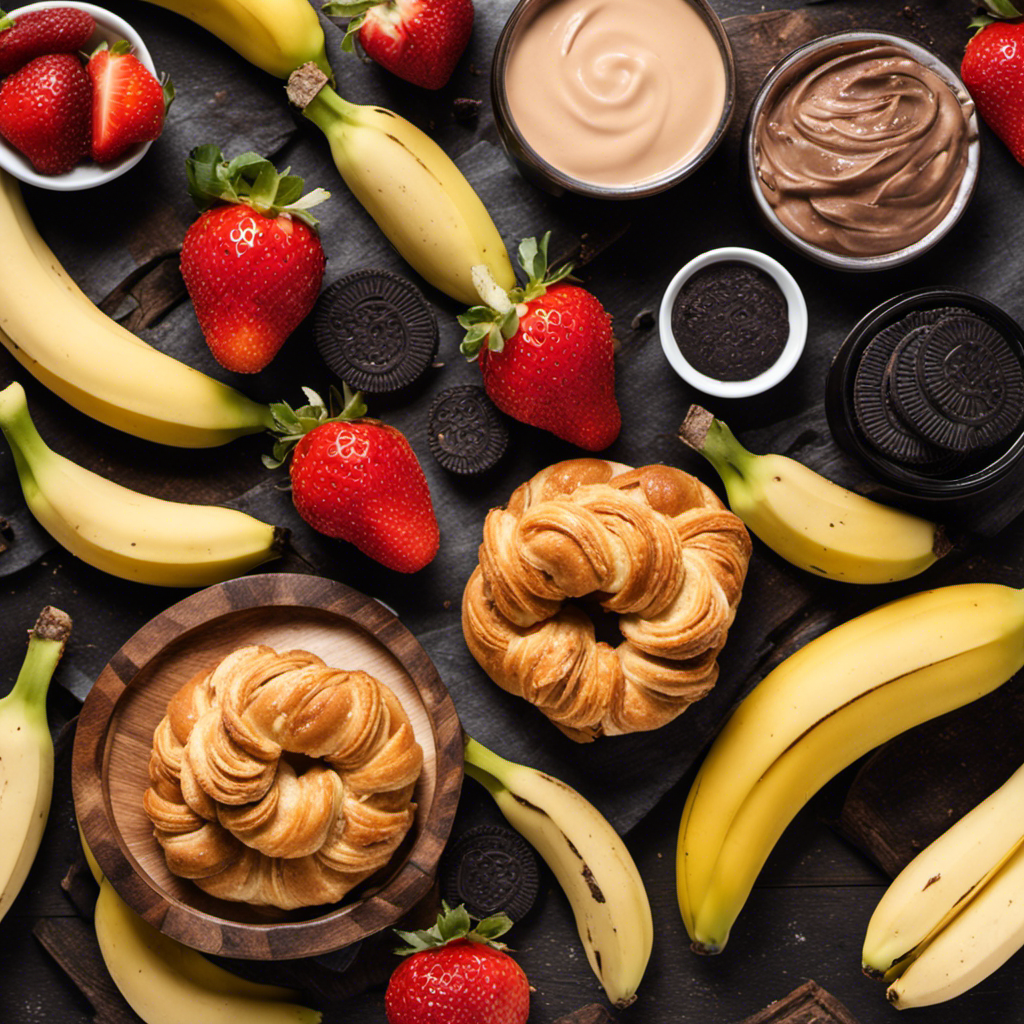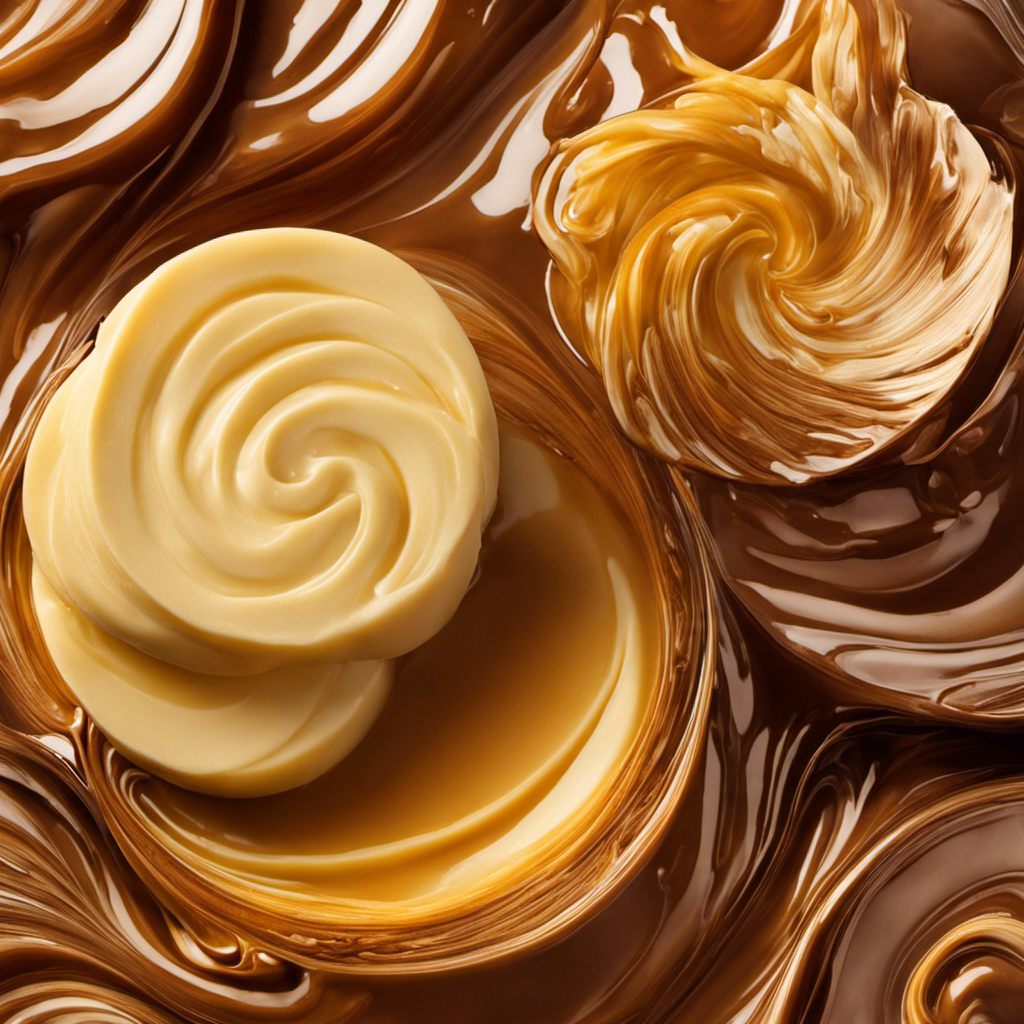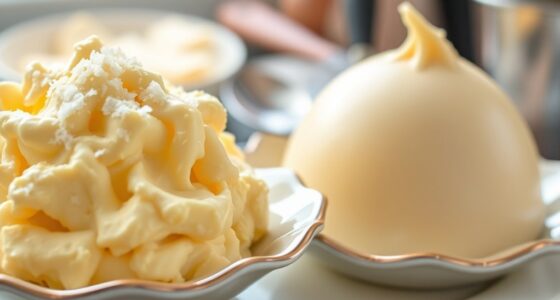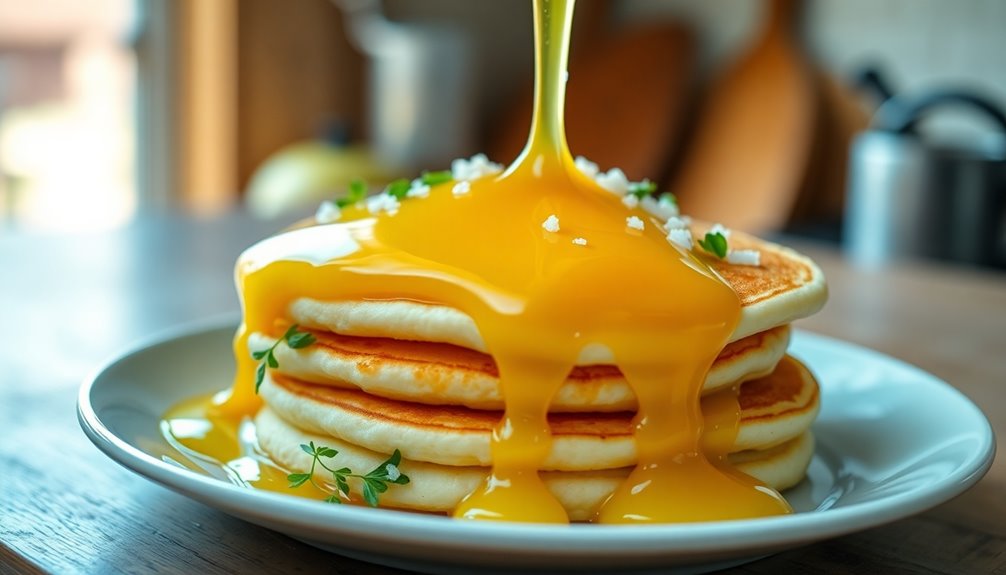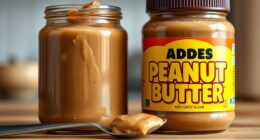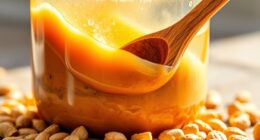I’m currently staring at a jar of creamy and irresistible cookie butter, wondering what delicious treat I should spread it on.
Well, the possibilities are endless! Whether it’s slathered on warm toast, spread on juicy fruits, or even drizzled over a tower of fluffy pancakes, cookie butter adds a burst of sweet, indulgent flavor to any dish.
Join me on a mouthwatering journey as we explore the many delicious ways to enjoy this heavenly creation.
Key Takeaways
- Cookie butter can be paired with a variety of breads and toasts, such as whole wheat or cinnamon raisin, to create delicious sandwiches or spreads.
- Fruits and berries can be enhanced by spreading cookie butter on them, incorporating it into smoothie bowls or parfait cups, or pairing it with yogurt and fresh berries.
- Pancakes and waffles can be topped with cookie butter and complemented with fresh berries, sliced bananas, or chopped nuts for a delightful breakfast or dessert option.
- Cookie butter can be enjoyed with crackers and pretzels, or even alternative options like flavored creams and fruit spreads, for a tasty snack. Additionally, it can be paired with both sweet and savory toppings like sea salt, fresh strawberries, cayenne pepper, or mild cheese to create interesting flavor combinations.
Breads and Toasts
You can spread cookie butter on breads and toasts for a delicious treat. One of my favorite ways to enjoy cookie butter is by making cookie butter sandwiches. Simply spread a generous amount of cookie butter between two slices of bread and you have a sweet and satisfying snack.
The creamy and rich texture of the cookie butter pairs perfectly with the softness of the bread. If you want to add a twist to your sandwich, try using different types of bread such as whole wheat or cinnamon raisin.
Another option is to spread cookie butter on a toasted bagel. The combination of the warm, crispy bagel with the sweet and nutty flavor of the cookie butter is simply irresistible.
Fruits and Berries
Spread some of that delicious cookie butter on your favorite fruits and berries for a sweet and creamy treat. Not only does it add a burst of flavor, but it also brings a smooth and velvety texture to your dishes.
One way to enjoy cookie butter with fruits is by incorporating it into smoothie bowls and açai bowls. Simply blend some frozen fruits, açai, and a dollop of cookie butter for a refreshing and indulgent breakfast.
Another option is to layer cookie butter with yogurt in parfait cups, alternating with fresh berries and crunchy granola. The combination of the tangy yogurt, sweet cookie butter, juicy fruits, and crispy granola creates a delightful harmony of flavors and textures.
Whether you’re starting your day with a vibrant smoothie bowl or treating yourself to a yogurt parfait, cookie butter and fruits make a winning combination that will satisfy your sweet tooth.
Pancakes and Waffles
One way to enjoy a delicious and indulgent breakfast is by topping your pancakes and waffles with a dollop of creamy and sweet cookie butter. Not only does it add a burst of flavor, but it also provides a smooth and velvety texture that complements the fluffy pancakes or crispy waffles perfectly.
Here are four creative pancake toppings that pair exceptionally well with cookie butter:
-
Fresh berries: The tartness of strawberries, blueberries, or raspberries beautifully contrasts with the sweetness of cookie butter.
-
Sliced bananas: The natural sweetness of ripe bananas enhances the overall flavor profile and adds a delightful creaminess.
-
Chopped nuts: Whether it’s walnuts, almonds, or pecans, the crunchy texture of nuts adds a satisfying contrast to the creamy cookie butter.
-
Whipped cream: A generous dollop of homemade whipped cream on top of cookie butter-coated pancakes or waffles takes the indulgence to another level.
Crackers and Pretzels
When it comes to crackers and pretzels, the possibilities are endless. Whether you prefer a sweet or savory snack, these crunchy treats can be enjoyed in a variety of ways.
In addition to traditional dips like hummus and cheese, there are also alternative options like flavored creams and fruit spreads that can take your snacking experience to a whole new level.
Sweet or Savory
You can’t go wrong with either sweet or savory toppings for your cookie butter. The versatility of cookie butter allows for a wide range of flavor combinations that will surely satisfy your taste buds. Here are four unique flavor pairings that you can try with your cookie butter:
-
Sweet and Salty: Spread your cookie butter on a slice of toasted bread and top it with a sprinkle of sea salt. The combination of the creamy sweetness of the cookie butter and the savory saltiness creates a perfect balance of flavors.
-
Fruity Twist: Spread cookie butter on a rice cake and add slices of fresh strawberries on top. The tanginess of the strawberries complements the rich sweetness of the cookie butter, creating a delightful fruity twist.
-
Spicy Surprise: Spread cookie butter on a warm tortilla and sprinkle it with a pinch of cayenne pepper. The hint of spice adds a surprising kick to the sweet and nutty flavor of the cookie butter.
-
Cheesy Delight: Spread cookie butter on a crisp cracker and top it with a slice of mild cheese. The combination of the creamy cookie butter and the smooth cheese creates a deliciously indulgent treat.
Alternative Dipping Options
If you’re feeling adventurous, try dipping your favorite pretzels or fruit slices into this delectable spread.
While cookie butter is typically enjoyed on its own or spread on toast, there are plenty of alternative dipping options that can take your snacking experience to the next level.
One unique flavor pairing is to dip salty potato chips into the sweet and creamy cookie butter. The combination of the salty and savory chips with the rich and indulgent spread creates a mouthwatering contrast of flavors.
Another option is to dip crunchy celery sticks into the cookie butter. The refreshing crunch of the celery complements the smooth texture of the spread, adding a fresh and healthy element to your snacking.
Ice Cream and Desserts
One popular choice is to spread cookie butter on top of ice cream for a deliciously indulgent dessert. The creamy, sweet flavor of the cookie butter pairs perfectly with the cold, smooth texture of the ice cream. It’s a match made in dessert heaven!
But why stop there? Here are four more ways to enjoy cookie butter in your favorite frozen treats:
-
Cookie Butter Milkshakes: Blend cookie butter with milk, ice cream, and a splash of vanilla extract for a decadent milkshake that will satisfy your sweet tooth.
-
Cookie Butter Cheesecake: Add a dollop of cookie butter to your cheesecake batter for an extra layer of richness and flavor. Swirl it in for a marbled effect or use it as a topping.
-
Cookie Butter Ice Cream Sandwiches: Spread cookie butter between two cookies and sandwich it with a scoop of your favorite ice cream. It’s the ultimate indulgence.
-
Cookie Butter Sundae: Drizzle warm cookie butter over your favorite ice cream flavors, and top with whipped cream, nuts, and a cherry for a truly indulgent sundae experience.
Smoothies and Shakes
After indulging in cookie butter on ice cream and other desserts, I decided to explore its potential in smoothies and shakes. I was amazed at how versatile this delectable spread could be! Not only does it add a rich and creamy texture to my smoothies, but the sweet and nutty flavor takes them to a whole new level. To enhance the experience, I started experimenting with different smoothie bowl toppings. From fresh fruits like sliced bananas and berries to crunchy granola and chia seeds, the possibilities were endless. And let’s not forget about cookie butter milkshakes! Blending cookie butter with milk and a scoop of vanilla ice cream creates a heavenly treat that satisfies all my dessert cravings. Whether it’s a nutritious smoothie bowl or a decadent milkshake, cookie butter has certainly become my go-to ingredient for adding a touch of indulgence to my drinks.
| Smoothie Bowl Toppings | Cookie Butter Milkshakes |
|---|---|
| Sliced bananas | Chocolate chips |
| Fresh berries | Whipped cream |
| Crunchy granola | Caramel drizzle |
Pastries and Cakes
When it comes to breakfast pastries, finding the perfect pairing can take your morning meal to the next level. Whether it’s a flaky croissant with a dollop of cookie butter or a warm cinnamon roll slathered in Nutella, the possibilities are endless.
And let’s not forget about unexpected cake combinations, like a tangy lemon cake with a creamy strawberry filling, or a rich chocolate cake layered with a peanut butter frosting.
Lastly, if you’re looking to get creative with your cookie butter, try spreading it on top of freshly baked cookies, swirling it into your favorite brownie batter, or even using it as a sweet and nutty filling for homemade donuts. The options are as diverse as they are delicious.
Breakfast Pastry Pairings
For breakfast, you can’t go wrong with some warm toast and a generous spread of cookie butter. It’s the perfect combination of sweet and savory that satisfies my morning cravings.
But if you’re looking to take your breakfast game to the next level, here are four delicious breakfast pastry pairings that incorporate cookie butter:
-
Cookie Butter Filled Croissants: Imagine biting into a flaky, buttery croissant filled with a creamy cookie butter filling. It’s a match made in breakfast heaven.
-
Cookie Butter Stuffed Pancakes: Take your pancakes to a whole new level by spreading cookie butter between each layer. The warm, gooey filling adds a burst of flavor with every bite.
-
Cookie Butter Breakfast Sandwich: Swap out your usual condiments and spread some cookie butter on your breakfast sandwich. The combination of savory eggs, crispy bacon, and sweet cookie butter is surprisingly delicious.
-
Cookie Butter French Toast: Dip your French toast in a mixture of beaten eggs and cookie butter, then cook it until golden brown. The result is a decadent and indulgent breakfast treat.
These breakfast pastry pairings will definitely elevate your morning routine and satisfy your cookie butter cravings. Give them a try and prepare to be delighted!
Unexpected Cake Combinations
To elevate your cake game, try combining unexpected flavors like zucchini and lemon for a refreshing and unique dessert experience. Zucchini may not be the first ingredient that comes to mind when you think of cake, but trust me, it works wonders. The zucchini adds moisture and a subtle earthiness, while the lemon provides a bright and tangy kick. It’s a combination that will leave your taste buds craving more.
And speaking of unexpected pairings, have you ever thought about incorporating cookie butter into your cake recipes? Cookie butter, with its creamy and sweet flavor, adds a rich and indulgent element to any cake. Whether you swirl it into the batter or use it as a frosting, the result is a decadent dessert that will have everyone asking for seconds.
And if you’re feeling adventurous, why not try making cookie butter cocktails to accompany your cake? The possibilities are endless when it comes to combining unexpected flavors and creating unforgettable desserts.
Creative Cookie Butter Uses
Have you ever thought about getting creative with your use of cookie butter in different recipes? Well, let me tell you, the possibilities are endless!
Here are four delicious ideas to inspire you:
-
Cookie Butter Cocktails: Mix cookie butter with your favorite liquor and some ice for a creamy and indulgent drink. It’s like dessert in a glass!
-
Cookie Butter Popcorn: Melt some cookie butter and drizzle it over freshly popped popcorn. The sweet and salty combination is addictive!
-
Cookie Butter Pancakes: Add a dollop of cookie butter to your pancake batter for a rich and flavorful twist on a breakfast classic. Top with syrup and enjoy!
-
Cookie Butter Ice Cream: Swirl cookie butter into your homemade or store-bought ice cream for a decadent treat. The creamy texture and cookie flavor will have you coming back for more.
Frequently Asked Questions
Can Cookie Butter Be Used as a Spread for Savory Sandwiches or Wraps?
Yes, cookie butter can be used as a spread for savory sandwiches or wraps. It adds a unique touch of sweetness that pairs well with savory ingredients, creating a delicious balance of flavors. However, there are also other spreads that can be used as alternatives to cookie butter in sandwiches or wraps.
Is There a Recommended Type of Bread or Toast That Pairs Best With Cookie Butter?
When it comes to pairing cookie butter with bread or toast, I recommend going for a warm and toasty option. Something like freshly baked brioche or a golden, buttery croissant. It’s like spreading a sweet and creamy dream on a cloud.
Are There Any Fruits or Berries That Should Be Avoided When Pairing With Cookie Butter?
Avoid pairing cookie butter with tart fruits like lemons or sour berries. The creamy sweetness of cookie butter is best complemented by milder fruits such as bananas or strawberries.
Can Cookie Butter Be Used as a Topping for Savory Pancakes or Waffles?
As an avid cook, I love experimenting with different flavors. When it comes to cookie butter, the possibilities are endless. From sweet pancakes to savory waffles, cookie butter adds a delicious twist to any dish.
Are There Any Specific Types of Crackers or Pretzels That Are Particularly Delicious When Paired With Cookie Butter?
When it comes to pairing cookie butter, the best cookies to use are graham crackers and pretzels. They provide a perfect balance of sweetness and saltiness. Plus, you can get creative by incorporating cookie butter into desserts like brownies or cheesecake.
Conclusion
In conclusion, cookie butter is a versatile and indulgent treat that can be enjoyed in various ways. Whether it’s spread on warm toast, drizzled over ice cream, or used as a filling for pastries, cookie butter adds a delightful sweetness to any dish.
It’s like a magical spoonful of joy that turns ordinary moments into extraordinary ones. Just like a sprinkle of fairy dust, cookie butter transforms simple ingredients into something truly enchanting.
So go ahead, let your imagination soar and explore the countless possibilities of this delectable spread.
